2002 MERCEDES-BENZ CLK430 CABRIOLET ESP
[x] Cancel search: ESPPage 281 of 346
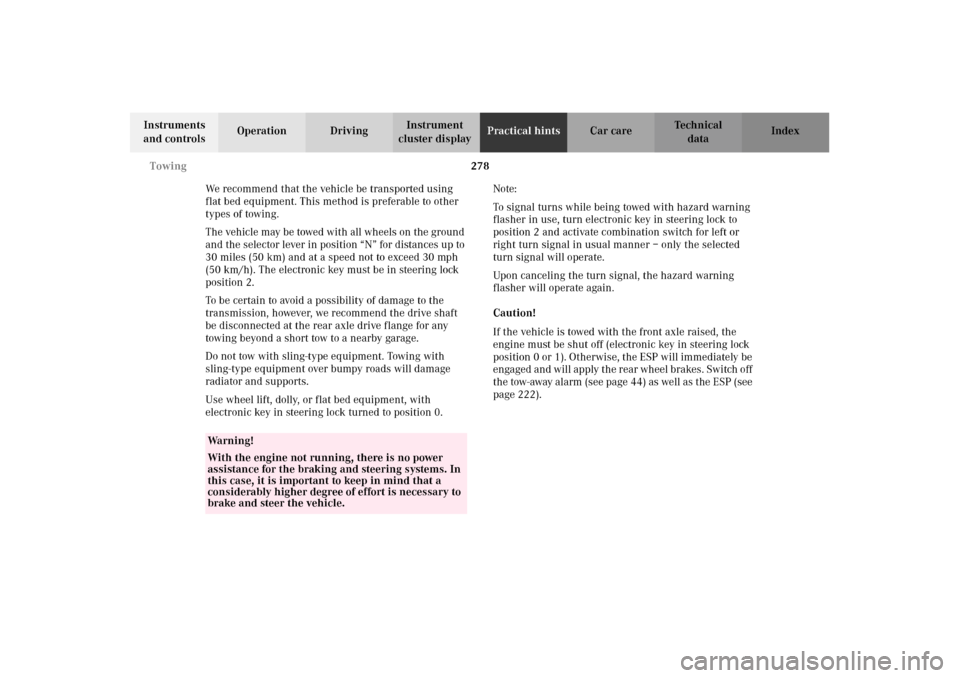
278 Towing
Technical
data Instruments
and controlsOperation DrivingInstrument
cluster displayPractical hintsCar care Index
We recommend that the vehicle be transported using
flat bed equipment. This method is preferable to other
types of towing.
The vehicle may be towed with all wheels on the ground
and the selector lever in position “N” for distances up to
30 miles (50 km) and at a speed not to exceed 30 mph
(50 km/h). The electronic key must be in steering lock
position 2.
To be certain to avoid a possibility of damage to the
transmission, however, we recommend the drive shaft
be disconnected at the rear axle drive flange for any
towing beyond a short tow to a nearby garage.
Do not tow with sling-type equipment. Towing with
sling-type equipment over bumpy roads will damage
radiator and supports.
Use wheel lift, dolly, or flat bed equipment, with
electronic key in steering lock turned to position 0.Note:
To signal turns while being towed with hazard warning
flasher in use, turn electronic key in steering lock to
position 2 and activate combination switch for left or
right turn signal in usual manner – only the selected
turn signal will operate.
Upon canceling the turn signal, the hazard warning
flasher will operate again.
Caution!
If the vehicle is towed with the front axle raised, the
engine must be shut off (electronic key in steering lock
position 0 or 1). Otherwise, the ESP will immediately be
engaged and will apply the rear wheel brakes. Switch off
the tow-away alarm (see page 44) as well as the ESP (see
page 222).
Wa r n i n g !
With the engine not running, there is no power
assistance for the braking and steering systems. In
this case, it is important to keep in mind that a
considerably higher degree of effort is necessary to
brake and steer the vehicle.
J_A208.book Seite 278 Donnerstag, 31. Mai 2001 9:35 09
Page 316 of 346

313 Technical data
Technical
data Instruments
and controlsOperation DrivingInstrument
cluster displayPractical hints Car care Index Technical data
Model CLK 320 (208 465)
1
CLK 430 (208 470)
1
CLK 55 AMG (208 474)
1
Engine11 2 113 113
Mode of operation 4-stroke engine,
gasoline injection4-stroke engine,
gasoline injection4-stroke engine,
gasoline injection
No. of cylinders688
Bore 3.54 in (89.90 mm) 3.54 in (89.90 mm) 3.82 in (97.00 mm)
Stroke 3.31 in (84.00 mm) 3.31 in (84.00 mm) 3.60 in (92.00 mm)
Total piston displacement 195.2 cu.in. (3199 cm
3) 260.3 cu.in. (4265 cm
3) 322.0 cu.in. (5439 cm
3)
Compression ratio 10:1 10:1 10.5:1
Output acc. to SAE J 1349 215 hp/5700 rpm
(160 kW/5700 rpm)275 hp/5750 rpm
(205 kW/5750 rpm)342 hp/5500 rpm
(255 kW/5500 rpm)
Maximum torque acc. to SAE J 1349 232 ft.lb/3000 rpm
(315 Nm/3000 rpm)295 ft.lb/3200 rpm
(400 Nm/3200 rpm)376 ft.lb/3000 rpm
(510 Nm/3000 rpm)
Maximum engine speed 6000 rpm 6000 rpm 6000 rpm
Firing order 1-4-3-6-2-5 1-5-4-2-6-3-7-8 1-5-4-2-6-3-7-8
Poly-V-belt 2390 mm 2390 mm 2390 mm
1 The quoted data apply only to the standard vehicle. See an authorized Mercedes-Benz Center for the
corresponding data of all special bodies and special equipment.
J_A208.book Seite 313 Donnerstag, 31. Mai 2001 9:35 09
Page 321 of 346
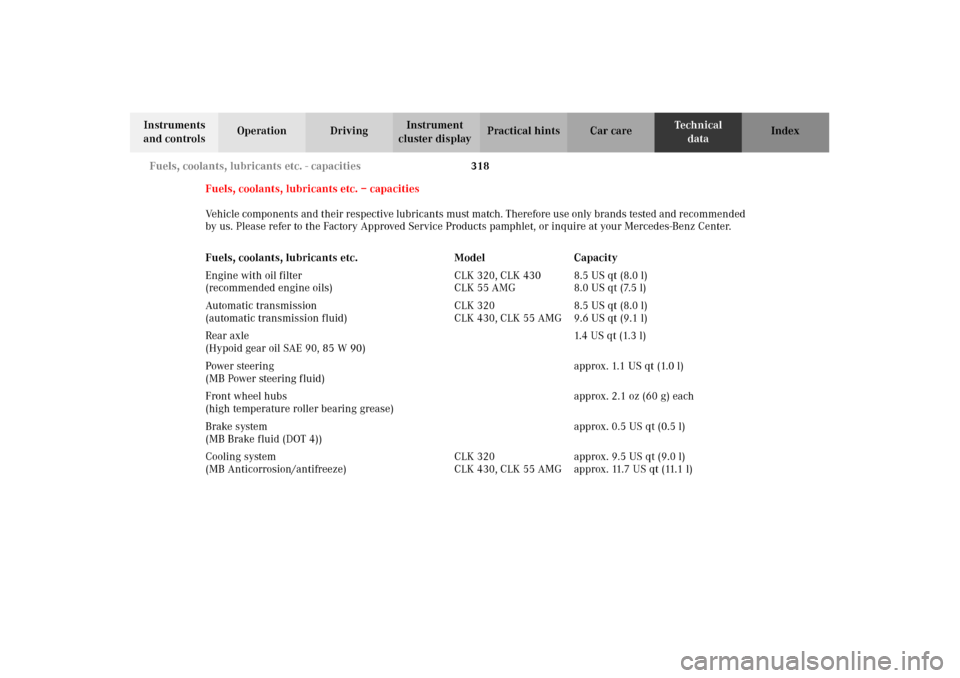
318 Fuels, coolants, lubricants etc. - capacities
Technical
data Instruments
and controlsOperation DrivingInstrument
cluster displayPractical hints Car care Index
Fuels, coolants, lubricants etc. – capacities
Vehicle components and their respective lubricants must match. Therefore use only brands tested and recommended
by us. Please refer to the Factory Approved Service Products pamphlet, or inquire at your Mercedes-Benz Center.
Fuels, coolants, lubricants etc. Model Capacity
Engine with oil filter
(recommended engine oils)CLK 320, CLK 430
CLK 55 AMG8.5 US qt (8.0 l)
8.0 US qt (7.5 l)
Automatic transmission
(automatic transmission fluid)CLK 320
CLK 430, CLK 55 AMG8.5 US qt (8.0 l)
9.6 US qt (9.1 l)
Rear axle
(Hypoid gear oil SAE 90, 85 W 90)1.4 US qt (1.3 l)
Power steering
(MB Power steering fluid)approx. 1.1 US qt (1.0 l)
Front wheel hubs
(high temperature roller bearing grease)approx. 2.1 oz (60 g) each
Brake system
(MB Brake fluid (DOT 4))approx. 0.5 US qt (0.5 l)
Cooling system
(MB Anticorrosion/antifreeze)CLK 320
CLK 430, CLK 55 AMGapprox. 9.5 US qt (9.0 l)
approx. 11.7 US qt (11.1 l)
J_A208.book Seite 318 Donnerstag, 31. Mai 2001 9:35 09
Page 325 of 346
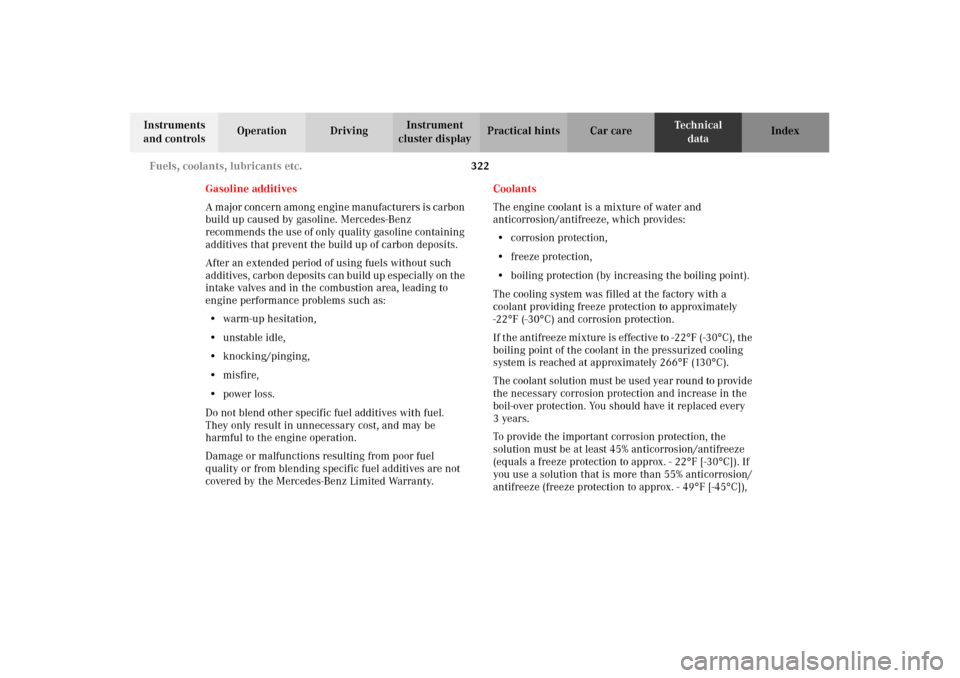
322 Fuels, coolants, lubricants etc.
Technical
data Instruments
and controlsOperation DrivingInstrument
cluster displayPractical hints Car care Index
Gasoline additives
A major concern among engine manufacturers is carbon
build up caused by gasoline. Mercedes-Benz
recommends the use of only quality gasoline containing
additives that prevent the build up of carbon deposits.
After an extended period of using fuels without such
ad ditives , car bon d ep osits c an bui ld up esp eci ally on t he
intake valves and in the combustion area, leading to
engine performance problems such as:
•warm-up hesitation,
•unstable idle,
•knocking/pinging,
•misfire,
•power loss.
Do not blend other specific fuel additives with fuel.
They only result in unnecessary cost, and may be
harmful to the engine operation.
Damage or malfunctions resulting from poor fuel
quality or from blending specific fuel additives are not
covered by the Mercedes-Benz Limited Warranty.Coolants
The engine coolant is a mixture of water and
anticorrosion/antifreeze, which provides:
•corrosion protection,
•freeze protection,
•boiling protection (by increasing the boiling point).
The cooling system was filled at the factory with a
coolant providing freeze protection to approximately
-22
°F (-30
°C) and corrosion protection.
If the antifreeze mixture is effective to -22
°F (-30
°C), the
boiling point of the coolant in the pressurized cooling
system is reached at approximately 266
°F (130
°C).
The coolant solution must be used year round to provide
the necessary corrosion protection and increase in the
boil-over protection. You should have it replaced every
3years.
To provide the important corrosion protection, the
solution must be at least 45% anticorrosion/antifreeze
(equals a freeze protection to approx. - 22
°F [-30
°C]). If
you use a solution that is more than 55% anticorrosion/
antifreeze (freeze protection to approx. - 49
°F [-45
°C]),
J_A208.book Seite 322 Donnerstag, 31. Mai 2001 9:35 09
Page 328 of 346
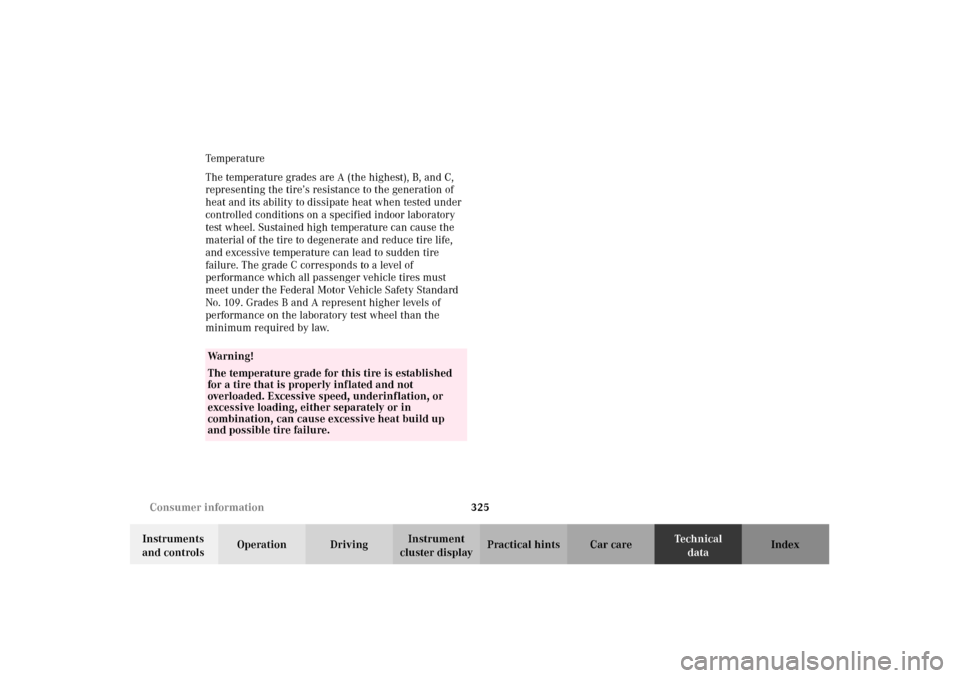
325 Consumer information
Technical
data Instruments
and controlsOperation DrivingInstrument
cluster displayPractical hints Car care Index Tempera t u re
The temperature grades are A (the highest), B, and C,
representing the tire’s resistance to the generation of
heat and its ability to dissipate heat when tested under
controlled conditions on a specified indoor laboratory
test wheel. Sustained high temperature can cause the
material of the tire to degenerate and reduce tire life,
and excessive temperature can lead to sudden tire
failure. The grade C corresponds to a level of
performance which all passenger vehicle tires must
meet under the Federal Motor Vehicle Safety Standard
No. 109. Grades B and A represent higher levels of
performance on the laboratory test wheel than the
minimum required by law.
Wa r n i n g !
The temperature grade for this tire is established
for a tire that is properly inflated and not
overloaded. Excessive speed, underinflation, or
excessive loading, either separately or in
combination, can cause excessive heat build up
and possible tire failure.
J_A208.book Seite 325 Donnerstag, 31. Mai 2001 9:35 09
Page 332 of 346
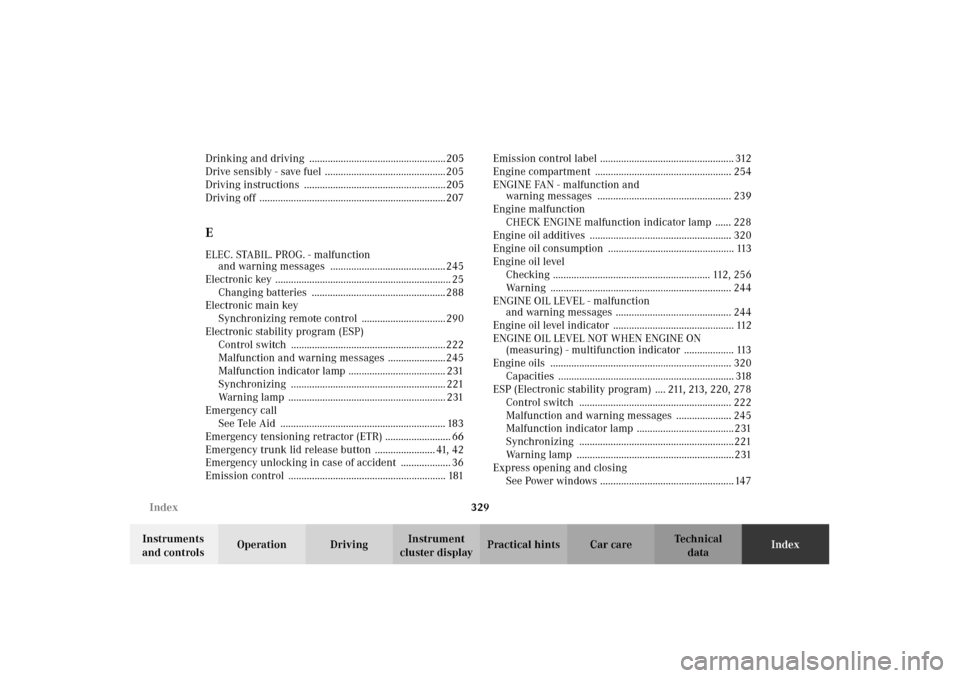
329 Index
Technical
data Instruments
and controlsOperation DrivingInstrument
cluster displayPractical hints Car careIndex Drinking and driving ....................................................205
Drive sensibly - save fuel ..............................................205
Driving instructions ......................................................205
Driving off .......................................................................207
EELEC. STABIL. PROG. - malfunction
and warning messages ............................................ 245
Electronic key ................................................................... 25
Changing batteries ................................................... 288
Electronic main key
Synchronizing remote control ................................ 290
Electronic stability program (ESP)
Control switch ...........................................................222
Malfunction and warning messages ......................245
Malfunction indicator lamp ..................................... 231
Synchronizing ........................................................... 221
Warning lamp ............................................................ 231
Emergency call
See Tele Aid ............................................................... 183
Emergency tensioning retractor (ETR) ......................... 66
Emergency trunk lid release button ....................... 41, 42
Emergency unlocking in case of accident ................... 36
Emission control ............................................................ 181Emission control label ................................................... 312
Engine compartment .................................................... 254
ENGINE FAN - malfunction and
warning messages ................................................... 239
Engine malfunction
CHECK ENGINE malfunction indicator lamp ...... 228
Engine oil additives ...................................................... 320
Engine oil consumption ................................................ 113
Engine oil level
Checking ............................................................ 112, 256
Warning ..................................................................... 244
ENGINE OIL LEVEL - malfunction
and warning messages ............................................ 244
Engine oil level indicator .............................................. 112
ENGINE OIL LEVEL NOT WHEN ENGINE ON
(measuring) - multifunction indicator ................... 113
Engine oils ..................................................................... 320
Capacities ................................................................... 318
ESP (Electronic stability program) .... 211, 213, 220, 278
Control switch .......................................................... 222
Malfunction and warning messages ..................... 245
Malfunction indicator lamp ..................................... 231
Synchronizing ...........................................................221
Warning lamp ............................................................231
Express opening and closing
See Power windows ................................................... 147
J_A208.book Seite 329 Donnerstag, 31. Mai 2001 9:35 09